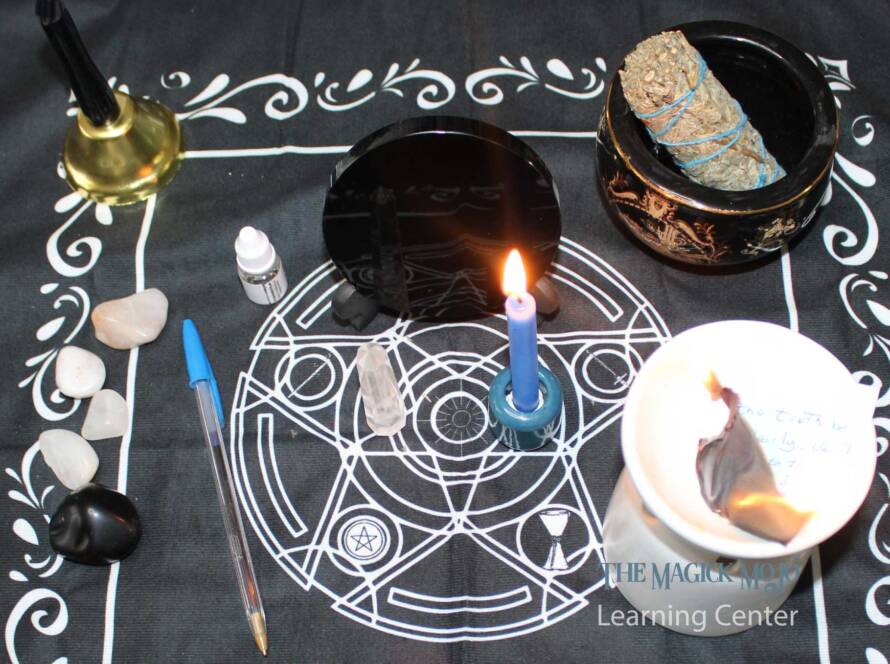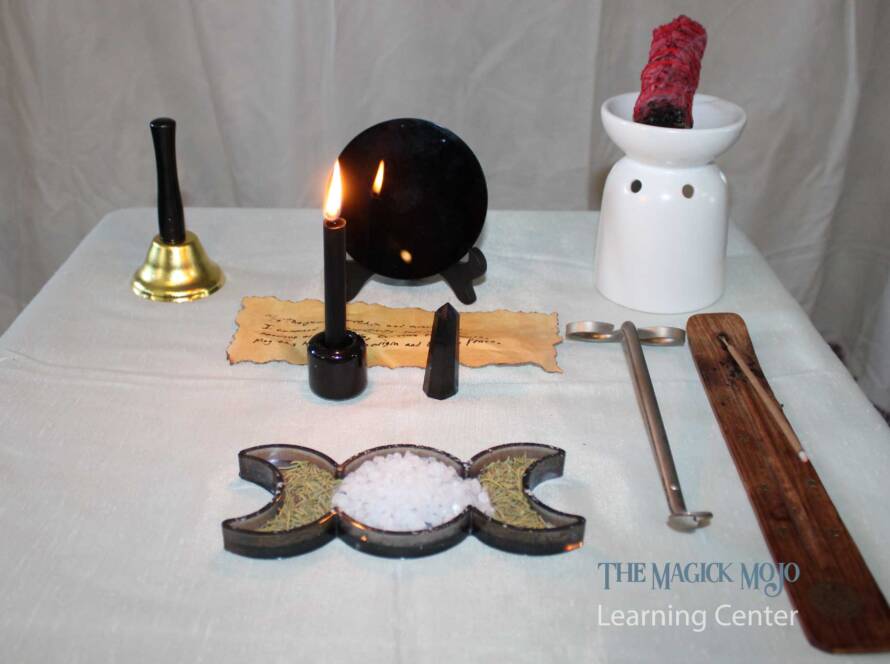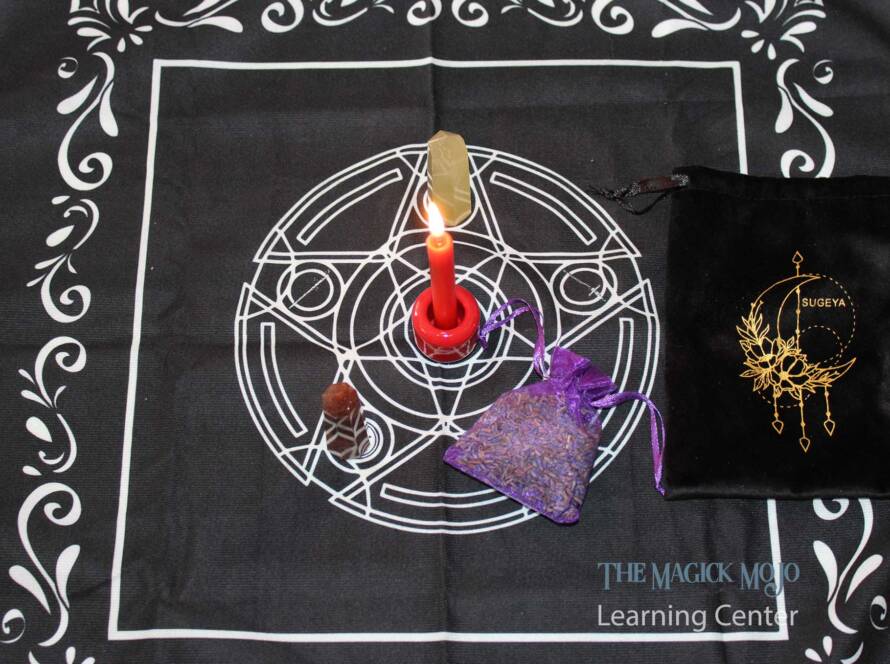- Table of Contents
- Understanding Binding Spells: What They Are and How They Work
- The Power of Intention in Binding Spells: Setting Clear Goals and Intentions
- Ethics and Consequences: Using Binding Spells Responsibly and with Care
- Removing Harmful Influences: A Combined Binding and Banishing Spell
- Spell Card
- Additional Resources
This article is an introduction to binding spells and how they are used to prevent or restrict the actions of a person, place, or thing. These spells can be used for a variety of purposes, such as protection, preventing harm, or enforcing boundaries. Binding spells can be used to prevent a person from causing harm to themselves or others, or to restrict the actions of an entity or spirit.
Understanding Binding Spells: What They Are and How They Work
One of the main purposes of a binding spell is prevention. By binding a person or entity, practitioners can prevent them from causing harm or negative consequences. This can be particularly useful in situations where a person or entity is exhibiting dangerous or harmful behavior, such as a toxic relationship or a malevolent spirit. Binding spells can help to prevent harm before it occurs, creating a safe and protective environment.
Another purpose of binding spells is to protect oneself or others from harm. These spells can be used to prevent negative energies or entities from entering a space or affecting a person. Binding spells can also be used to protect a person from harm caused by others, such as preventing someone from casting spells against them or causing harm through negative intentions.
The Power of Intention in Binding Spells: Setting Clear Goals and Intentions
When performing a binding spell, intention is key. The practitioner should have a clear understanding of why they are performing the spell and what they hope to achieve. They should also have a clear and specific intention for the spell, such as binding a specific entity or preventing a specific action. This intention should be focused and precise in order to ensure that the spell is effective.
To set clear goals and intentions for a binding spell, practitioners can begin by meditating on their desired outcome. This can help them to connect with their intuition and inner wisdom, gaining insight into what needs to be done to achieve their goals. Once they have a clear understanding of what they hope to achieve, they can create a ritual or spell that is specifically tailored to their intentions.
One important aspect of setting intentions for a binding spell is to be mindful of the language and symbols used in the spell. The language and symbols used should reflect the specific intention of the spell, and should be chosen with care. Practitioners may choose to use specific herbs, crystals, or other magical tools that are associated with their intention. They may also incorporate specific words or symbols that are meaningful to them and reflect their desired outcome. By focusing on their intention and using specific tools and symbols, practitioners can create a powerful binding spell that is tailored to their specific needs and goals.
Ethics and Consequences: Using Binding Spells Responsibly and with Care
While binding spells can be a powerful tool for protection and prevention, they should be used with caution and ethical consideration. It is important to remember that using magic to control or harm others is never acceptable. Practitioners should always consider the potential consequences of their actions and use binding spells only as a last resort when all other methods of resolution have failed.
Practitioners should also be aware that binding spells can have unintended consequences, particularly if they are performed without proper preparation or understanding of the situation. It is important to consider all possible outcomes of a binding spell and be prepared to deal with any consequences that may arise. Practitioners should also be mindful of the potential harm that may come to themselves or others if the spell is not performed correctly.
In addition to ethical considerations, it is also important to follow proper ritual and magical protocols when performing a binding spell. This may include setting up a protective circle, grounding and centering oneself, and using the proper tools and symbols associated with the intention of the spell. Practitioners should also be prepared to deal with any unexpected challenges or obstacles that may arise during the spell.
Removing Harmful Influences: A Combined Binding and Banishing Spell
Binding spells and banishing spells are two different types of spells with different purposes. While binding spells are intended to restrain or limit a person, banishing spells are designed to remove a person or energy from a situation or space.
In terms of working in conjunction with each other, it would depend on the specific situation and intent of the practitioner. For example, if someone is causing harm or disruption in a particular environment, a practitioner might use a banishing spell to remove that person from the space. If that person continues to cause problems, the practitioner might then use a binding spell to prevent them from returning or causing further harm.
Alternatively, a practitioner might use a binding spell as a preventive measure, to stop someone from causing harm before it happens. In this case, a banishing spell might not be necessary if the person has not yet entered the situation.
It’s worth noting that both binding and banishing spells can have serious consequences, and should not be used lightly. It’s important to carefully consider the intended outcome and ethical implications of any spellwork before casting. Additionally, some practitioners may choose not to use binding or banishing spells at all, and instead focus on protective or positive spells that promote healing and harmony.

Binding Spell
Equipment
- Altar
Ingredients
- White ribbon or cord
- A photo or personal item of the person or thing being bound
- Pen and paper
Instructions
- Begin by creating a sacred space for the ritual. This can be done by casting a circle or using any other method that feels appropriate for you.
- Take the photo or personal item of the person or thing you wish to bind and hold it in your hand. Focus your energy on the item and visualize the energy of the person or thing being contained and restricted.
- Write the name of the person or thing on the piece of paper and place it on the altar or in front of you.
- Hold the white ribbon or cord and repeat the following incantation:"By the power of my will, I bind thee [name of person or thing] and restrict thy actions. May your harmful intentions be contained and your influence be diminished. So mote it be."
- Tie the ribbon or cord around the photo or personal item, visualizing the energy of the person or thing being contained within the ribbon.
- Thank the spirits, guides, or deities that you invoked for their assistance.
Notes
Additional Resources
Books
- “Protection Spells: Clear Negative Energy, Banish Unhealthy Influences, and Embrace Your Power” by Arin Murphy-Hiscock is a book that explores various protection spells, including binding spells. It provides step-by-step instructions and guidance on how to create and perform these spells safely and effectively.
- “The Witch’s Book of Shadows: The Craft, Lore & Magick of the Witch’s Grimoire” by Phyllis Curott is a comprehensive guide to creating and using a Book of Shadows. It includes information on spells, rituals, and magical tools, including binding spells.
- “Llewellyn’s Complete Book of Correspondences: A Comprehensive & Cross-Referenced Resource for Pagans & Wiccans” by Sandra Kynes is a valuable resource for practitioners of magic. It provides correspondences for various magical tools, including herbs, crystals, colors, and symbols, which can be used in binding spells and other forms of magic.
Websites
Learn Religions – This website offers a wide range of information on various spiritual and magical practices, including witchcraft and Wicca. It includes articles and resources on binding spells, as well as related topics such as protection magic and banishing spells.
Ancient Binding Spells, Amulets and Matt 16.18–19: Revisiting August Dell’s Proposal a Century Later – The Cambridge University Press has more than 420 peer-reviewed academic journals covering subjects across the humanities, social sciences and science, technology and medicine.
3 Ways to Use a Binding Spell – wikiHow is an award-winning website where trusted research and expert knowledge come together. · Authoritative 90,000 academically researched articles.



1 Comment